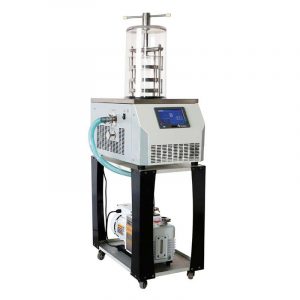The freeze-dryer is a piece of equipment that works by using vacuum freeze drying. With this device, the process of freeze-drying occurs, which is just an advanced dehydration process that removes all traces of water and moisture from the product and sublimates the ice, thanks to the low pressure to which it is subjected. Due to their incredible drying capacity, freeze-dried materials have superior quality and benefits compared to products dehydrated by other processes.
The main characteristic of the freeze-dryer is that it works at low temperature, which allows, for example, not to lose volatile products, which is contrary to a traditional drying process. The sublimation allows to pass directly from the solid state to the gas, ignoring the liquid state, which makes the obtained product porous and can easily rehydrate and recover its properties.
Freeze-drying is a method used in the food, pharmaceutical and archaeological industries. It dehydrates materials through a non-denaturing process and removes approximately 99% of moisture from them. Some products that can be freeze-dried are fruits, coffee, flowers, and medicines, as well as archaeological objects, among others. The archaeological products are made of dead vegetable fibers or wood, exposing them to an inappropriate environment, the biological and chemical processes would cause the complete disappearance of these, however, in environments of extreme dryness, due to the absence of water, the decomposition is slow. For this reason, the use of freeze-drying for archaeological wood has begun.
Freeze-dried archaeological pieces
Freeze-drying is known as a method of drying a previously frozen product under vacuum. The freeze-dryer removes the water contained in the organic material by sublimating it, i.e. turning it from solid to vapor. Freeze-drying has three essential steps: the freezing step, the primary drying step, and the secondary drying step.
This process is increasingly common in industries as a method of preserving organic matter. In archaeology, especially underwater, it is of great use because it allows the extraction of water from archaeological resources and to know the history of these. For example, by freeze-drying archaeological objects made of wood, the water present in them is transformed into ice, and then sublimates, after being subjected to vacuum. This process allows the objects to have a stable equilibrium and to preserve them in the environment.
Lyophilisate Urs
The freeze-dryer is a machine in charge of dehydrating, by freeze-drying, a given product, to this action it is called lyophilization or dehydro-freezing. This process has a great expansion in the food industry, pharmaceutical and archaeological allowing to maintain the original structure of the materials. The process of freeze-drying is completed in 3 fundamental steps:
- The freezing stage, one of the most critical and important, the product must be completely frozen, otherwise it can be damaged by being in an empty environment.
- The primary drying stage, this phase is of great durability because it is necessary to eliminate 90% of the physical water present in the material, by reducing the pressure and gradually applying heat to the frozen material.
- The secondary drying stage, is the phase where the highest vacuum is required and where all the water that is attached to the material is removed.
Kalstein freeze dryers
At Kalstein we are the best MANUFACTURERS of the best laboratory equipment useful in the field of science and medicine. We have a wide variety of models at the best prices on the market. If you are interested in BUYING one of our freeze dryers, we have table top and vertical freeze dryers, our normal table top laboratory freeze dryer YR series is characterized by:
- CFC-free cooling
- LCD screen drying curves, English interface
- Large condenser opening, condenser with pre-freeze function
- Low-noise compressor, good efficiency, long service life
To make your PURCHASE, you just have to connect to our catalog and to ask for the estimate of the desired product HERE

